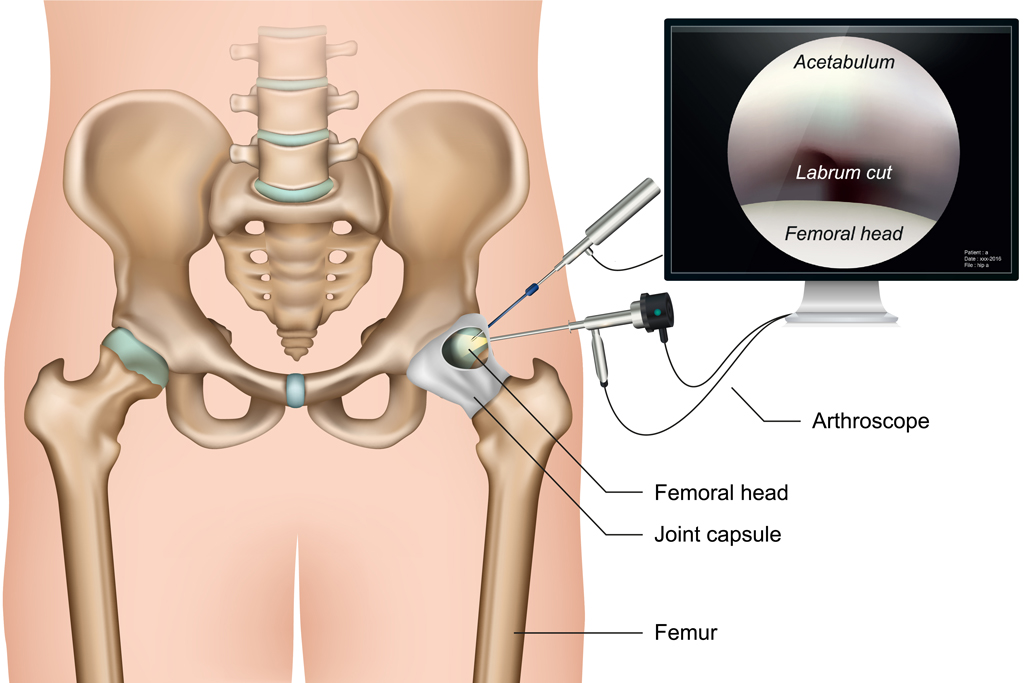
What is hip arthroscopy?
Hip arthroscopy, or hip preservation surgery, is a minimally invasive surgery designed to preserve your original hip. Hip arthroscopy allows the surgeon to work inside and around the hip joint through two or three small incisions no bigger than your pinky nail. A small video camera called an arthroscope is inserted into the hip joint to help the surgeon look for damage, assess the type of injury, and repair the problem simultaneously. This small camera then guides the surgeon as they use small instruments to treat the issue.
Hip arthroscopy is used to diagnose and treat various hip conditions, which include:
- Treatment of Femoroacetabular Impingement (FAI)
- Removal of loose bodies (torn cartilage or bone pieces)
- Repair a torn labrum (the fibrous cartilage ring that lines the acetabular socket)
- Removal of bone spurs or extra bone growths caused by arthritis or an injury
- Removal of part of the inflamed synovium (lining of the joint) in patients with inflammatory arthritis (This procedure is called a partial synovectomy.)
- Repair of fractures or torn ligaments caused by trauma
- Evaluation and diagnosis of conditions with unexplained pain, swelling, or stiffness in the hip that does not respond to conservative treatment
Advantages of hip arthroscopy include the following:
- Outpatient surgery
- Small incisions
- Minimal trauma to surrounding ligaments, muscles, and tissues
- Less pain
- Faster recovery
- Lower infection rate
- Less scarring
- Earlier mobilization
Who is not a candidate for hip arthroscopy/hip preservation:
- Advanced hip arthritis
- Advanced acetabular (cup) dysplasia
What is the recovery like?
Hip arthroscopy is an outpatient surgery. Surgery generally takes about on hour and a half to complete. You will typically go home the same day. Most patients will be on crutches/walker for about 2-3 weeks after surgery with progressive weight bearing throughout that time.
Physical therapy will start within a week of surgery, generally after your first postoperative visit. You will keep your surgical dressing clean, dry, and intact until this first postoperative appointment, which is generally about 5 days after surgery.
Patients typically return to driving when they are off narcotic pain medication and feel comfortable maneuvering the operative leg. This is typically about 10 days after surgery for the right leg and even sooner for the left leg.
Over the first few months after surgery you will work to normalize your gait (walking) and regain strength and range of motion. If returning to running is your goal, you will start a return to run program approximately 3-4 months after surgery. If you are returning to a competitive sport, you are generally cleared around the 6 month post op time period.
Wilmington Health’s Dr. Chad Fortun talks about hip arthroscopy in this edition of M.E.D. School for Patients.
WATCH THE VIDEO
Have hip pain? Turn to Wilmington Health
Our Orthopaedic team can help determine whether hip arthroscopy is right for you. Turn to Wilmington Health’s Orthopaedic and Sports Medicine department for TRUE Care regarding all your surgical and nonsurgical needs.
Wilmington Health’s Chad M. Fortun, MD, MS, is a specialist in treating hip pain through hip preservation. In addition to being board-certified and fellowship-trained, Dr. Fortun has had additional training in hip arthroscopy from some of the best and busiest hip arthroscopists in the country. Dr. Fortun has brought that experience and expertise to the Cape Fear region as the area’s only hip arthroscopist over the last six years. Over that period of time, he has developed a thriving sports medicine and hip arthroscopy practice, performing over 100 hip arthroscopies per year. While shoulder and knee arthroscopy has been widely used over the last 30 years, hip arthroscopy continues to grow. Advances in instrumentation and technique have made for excellent outcomes, but skill and experience are required to achieve these optimal results. Hip arthroscopy is an amazing tool that has the ability to change the course of a patient’s hip pain and return them to the activities they love.

